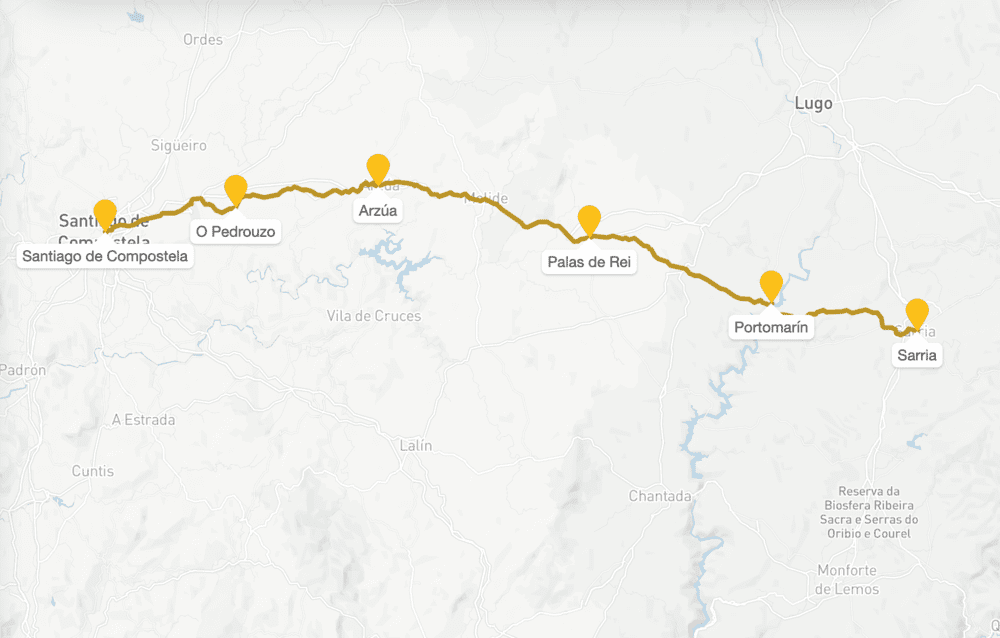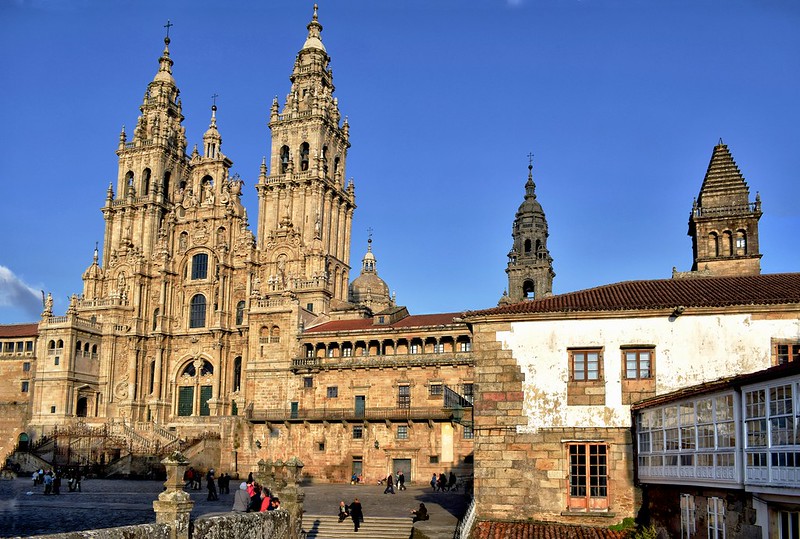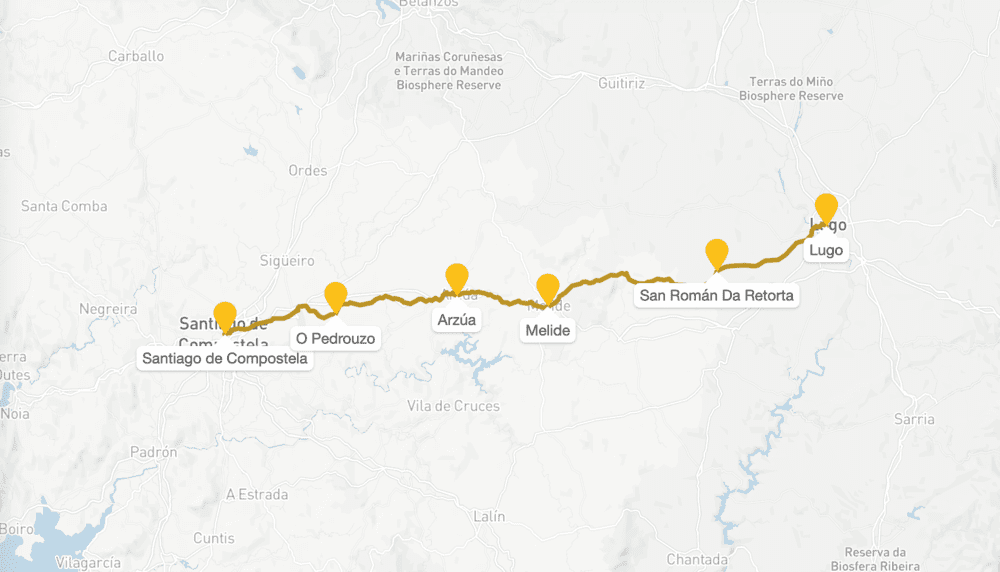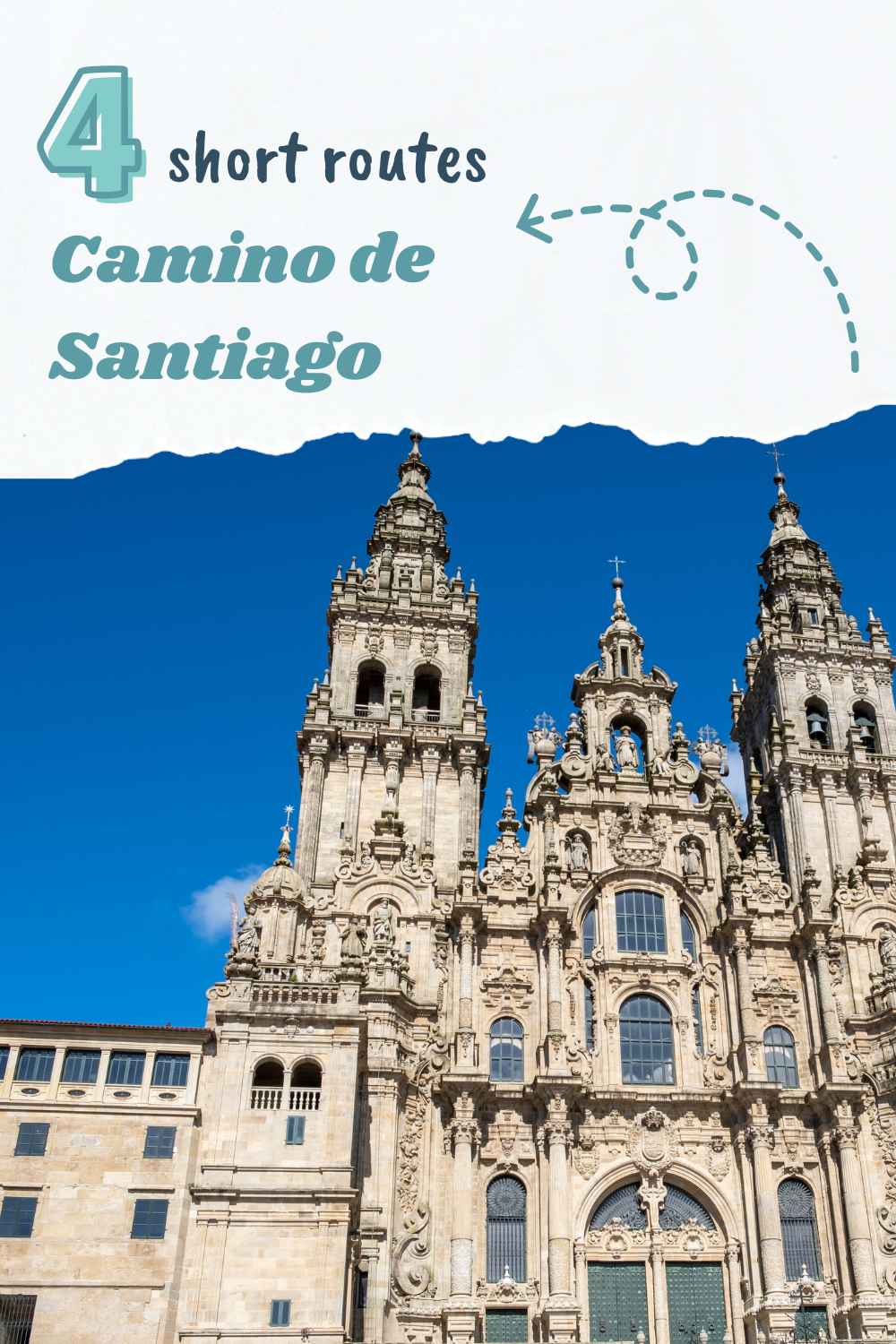There are many many routes to make the famous pilgrimage. Some of them do not even reach Santiago de Compostela starting and ending in other countries. The longest routes Camino del Norte and Via de la Plata are up to 1000km (over 600 miles) long and definitely take a lot more than a regular vacation. Not to mention a certain level of physical fitness and stamina. However, Camino is one of the bucket list experiences that most of us don’t want to miss. Here’s the list of Camino de Santiago short routes that can be done in under 1 week.
- Short Camino Francés: 6 days(110 km/68mi)
- Tip
- Sarria
- Day 1: Sarria – Portomarín (22 km/14mi)
- Day 2: Portomarín – Palas de Rei (19.7 km/12mi)
- Day 3: Palas de Rei – Arzúa (29 km/18mi)
- Day 4: Arzúa – O Pedrouzo (19 km/12mi)
- Day 5: O Pedrouzo – Santiago de Compostela (20 km/12.4mi)
- Santiago de Compostela
- Short Camino Fisterra: 4 days (78 km/48.5mi)
- Day 1: Santiago de Compostela – Negreira (20.6 km/12.8mi)
- Day 2: Negreira – Olveiroa (32.6 km/20.25mi)
- Day 3: Olveiroa – Cee (20 km/12.4mi)
- Day 4: Cee – Fisterra (20 km/12.4mi)
- Short Camino Primitivo: 5 days (97km/60mi)
- Lugo
- Day 1: Lugo – San Roman Da Retorta (27.7 km/17.2mi)
- Day 2: San Romao Da Retorta – Melide (29 km/18mi)
- Day 3: Melide – Arzúa (14 km/8.6mi)
- Day 4: Arzúa – O Pedrouzo (19 km/12mi)
- Day 5: O Pedrouzo – Santiago de Compostela (20 km/12.4mi)
- Short Camino Portugués: 6 days (103km/64mi)
- Tui
- Day 1: Tui – O Porriño (18.7 km/11.6mi)
- Day 2: O Porriño – Redondela (15.2 km/9.44mi)
- Day 3: Redondela – Pontevedra (15.5 km/9.6mi)
- Day 4: Pontevedra – Caldas de Reis (21.5 km/13.4mi)
- Day 5: Caldas de Reis – Padrón (19.5 km/12mi)
- Day 6: Padrón – Santiago de Compostela (24.3 km/15mi)
- Why Camino de Santiago Short Routes?
- Being Time Savvy ⏱️
- Less Demanding Physically 💪
- Personal Reflection 🧎♀️
- Experiencing the Variety of Landscapes 🌊
- Friendly on the Budget 💸
- Providing Opportunity for Social Connections 👥
Short Camino Francés: 6 days(110 km/68mi)
Tip
At the end of your Camino you will definitely want to obtain a Compostela certificate when you reach Santiago de Compostela. The prerequisite is walking the last 100 km/ 62 mi of camino. To provide proof you will need to bring credencial del peregrino (pilgrim passport) and at least 2 stamps from albergues on the way. The passport can be obtained beforehand from one of the approved organisations
SARRIA – SANTIAGO DE COMPOSTELA

Camino Francés is one of the most popular and the oldest routes. The first mention of this route occurs in Codex Calixtinus, dating back to 1140. The original starting point is French Saint Jean Pied de Port, making its length up to 800km/~500 mi. The thru-hike takes at least 1 month even for those most fit and experienced. That’s why the simplified itinerary is so recommended to start with:
Day 1 : Sarria – Portomarín
Day 2: Portomarín – Palas de Rei
Day 3: Palas de Rei – Arzúa
Day 4: Arzúa – O Pedrouzo
Day 5: O Pedrouzo – Santiago de Compostela
Day 6: Santiago de Compostela
Sarria
In case you have any extra time, you can spend it in Sarria. It’s an old town and being a pilgrimage point had an impact on its architecture. There are a number of religious buildings to see — the church of Santa Mariña, the convent of Magdalena, and the church of El Salvador.
Day 1: Sarria – Portomarín (22 km/14mi)
You will begin the Camino towards Portomarín, located next to the Miño River. The point of interest at this stage will be the church of Santa Maria in Ferreiros. Upon arrival to Portomarín, consider visiting the fortress-church of San Nicolás (an example of late Romanesque style architecture), the chapel Virgin de las Nieves, and the church of San Pedro. If you have more time in Portomarín you can view the mansions of Conde da Maza and dos Pimentales.
Day 2: Portomarín – Palas de Rei (19.7 km/12mi)
The next step on the Camino is Palas de Rei. It is regarded as a “council” of extreme artistic wealth, as clearly demonstrated by the church of San Tirso, the castle of Pambre, and the mansion of Ulloa.
Day 3: Palas de Rei – Arzúa (29 km/18mi)
Moving forward on the Camino, you will head towards Arzúa. At this stage you will pass through town of Melide. You can take a look at the town hall and throw a coin into the fountain of Cuatro Caños. When in Arzúa, you can take a look at the Parish Church of Santiago (you can get a stamp there as well) and the Chapel of Magdalena.
Day 4: Arzúa – O Pedrouzo (19 km/12mi)
This stage is considered the easiest and most scenic on this route. At the destination point, you can take a look at the chapel of Santa Irene.
Day 5: O Pedrouzo – Santiago de Compostela (20 km/12.4mi)
This stage doesn’t have any particular points of interest, except Monte de Gozo which opens up a view of the spires of Santiago Cathedral.
Santiago de Compostela
The final point of destination and a well-deserved rest. There is a whole variety of things to do and see. The first place, of course, is the cathedral and Plaza del Obradoiro square. It is worth attending the pilgrims’ mass, which is served every day between 12-00 and 18-00.

Apart from the cathedral, the Obradoiro square has another sight to see — Raxoi Palace, a piece of Neoclassic architecture dating back to the XVIII century.
The emblematic buildings to see are the Hostel of the Catholic Monarchs, Gelmirez Palace, the monastery of San Martin Pinario, the Arch of Xelmírez, and many more.
Santiago de Compostela has one of the oldest universities in Europe, founded in 1495.
Short Camino Fisterra: 4 days (78 km/48.5mi)
SANTIAGO DE COMPOSTELA – FISTERRA

Unlike other routes, Camino Finisterre is usually done in the opposite direction – beginning in Santiago and moving further to the coast. It’s often used as the extension to other routes, for those seeking more challenge. Fisterra derived its name from “Finis Terrae” which Romans used to refer to the “end of the world”. Interestingly, this route existed long before Christianity, used by pagans. The sun was believed to “die” in this place and there used to be an altar, Ara Solis, nothing of it is left today. Later on, the route was added to the Christian pilgrimage network.
If you don’t plan to spend any extra time to enjoy Santiago de Compostela, this route can be done within a short time of 4 days.
Day 1: Santiago de Compostela – Negreira
Day 2: Negreira – Olveiroa
Day 3: Olveiroa – Cee
Day 4: Cee – Fisterra
Day 1: Santiago de Compostela – Negreira (20.6 km/12.8mi)
The stage path runs through a pleasant rural landscape, with pine trees and eucalyptus. The hikers are passing through Ponte Maceira, a village, remarkable for its medieval stone bridge.
Negreira itself offers a baroque-styled fortress Pazo de Cotón.
Day 2: Negreira – Olveiroa (32.6 km/20.25mi)
The path from Negreira to Olveiroa is the longest in the itinerary. This hike is great for enjoying the rural environment and the great landscape of this region. The sights to see are the view over the Xallas valley and its waterfall as well the Fervenza reservoir.
Day 3: Olveiroa – Cee (20 km/12.4mi)
The hike is relatively short, going through a fairly steep descent. This stage has the following points of interest: Marco Do Couto crossing, the chapels of Nosa Señora Das Neves, and San Pedro Mártir.
Day 4: Cee – Fisterra (20 km/12.4mi)
This route offers views over the Atlantic Ocean, motivating the final push of the Camino. The path goes through forests, beaches, and cliffs. The opportunity no one will want to miss is visiting the lighthouse – for the views that gave Fisterra its name.
Short Camino Primitivo: 5 days (97km/60mi)
LUGO – SANTIAGO DE COMPOSTELA

The original Camino Primitivo is 268km/166mi long stretching from Oviedo to, of course, Santiago de Compostela. It is the very first route according to many sources. 2 weeks is the most optimistic estimate to do a full Camino Primitivo. Furthermore, this is one of the most physically demanding routes due to the rough terrain. That is why the short route is so recommended for beginners. Camino Primitivo’s short route is less than 100km/62mi and the last 2 stages overlap Camino Francés.
Day 1: Lugo – San Román Da Retorta
Day 2: San Román Da Retorta – Melide
Day 3: Melide – Arzúa
Day 4: Arzúa – O Pedrouzo
Day 5: O Pedrouzo – Santiago de Compostela
Lugo
The starting point of simplified Camino Primitivo. It has a galore of tourist attractions. The most notable one is Muralla de Lugo (Wall of Lugo). This piece of Roman architecture is a UNESCO heritage sight. On top of it, you should visit the House of Mosaics, the town hall with its clock tower, and the cathedral of Santa María.
Day 1: Lugo – San Roman Da Retorta (27.7 km/17.2mi)
The first stage will take you from Lugo to San Román Da Retorta, a small municipality with a great pilgrim tradition. There you can visit the church of San Roman Da Retorta and see the replica of a Roman milestone found in the town. The original is preserved in the Diocesan Museum of Astorga.
Day 2: San Romao Da Retorta – Melide (29 km/18mi)
In Melide, a municipality of pre-Roman origin, you can see the façade of the Romanesque church of San Pedro, a transept from the 14th century (considered the oldest in Galicia), and the Terra de Melide Museum (former monastery-hospital of Sancti Spiritus).
Day 3: Melide – Arzúa (14 km/8.6mi)
The stage from Melide to Arzúa is relatively short it runs through the forests. In the village of Ribadiso de Abaixo, pilgrims can swim in the river.
Day 4: Arzúa – O Pedrouzo (19 km/12mi)
As mentioned in the simplified Camino Francés, this stage doesn’t have a lot of attractions. But you may consider taking a look at the chapel of Santa Irene.
Day 5: O Pedrouzo – Santiago de Compostela (20 km/12.4mi)
The last hike goes through the forestry scenery. Except for the view from the Monte de Gozo, it doesn’t have any particular sights.
Short Camino Portugués: 6 days (103km/64mi)
TUI – SANTIAGO DE COMPOSTELA

The original Camino Portugués starts at Lisbon and stretches 620 km / 385 mi. The most optimistic time for a thru-hike is 27 days. The route emerged in the Middle Ages and is associated with the Reconquista and the kingdom of León. Its heyday was from XII to XII centuries when pilgrims from all over Portugal were taking it heading north. However, in the XIV century, the number of pilgrims began to decline. But at the end of XX century, the route had a renaissance, when the Councill of Europe recognized it as the first cultural route. Later on, it was added to the UNESCO World Heritage List.
It runs along the coast through all major Portuguese cities. Here we will consider the last 100km/64mi of Camino Portugués, running through the provinces of Pontevedra and A Coruña.
Day 1: Tui – O Porriño
Day 2: O Porriño – Redondela
Day 3: Redondela – Pontevedra
Day 4: Pontevedra – Caldas de Reis
Day 5: Caldas de Reis – Padrón
Day 6: Padrón – Santiago de Compostela
Tui
Tui is located at the very border with Portugal, so the simplified Camino Portugués will actually not pass through Portugal itself. Nevertheless, Tui offers a range of tourist attractions. In particular, are the International Bridge over the Miño River, “Fortaleza” – the preserved remains of the wall (12th century), the street Porta da Pía, the cathedral of Santa María, the Diocesan museum, the chapel of San Telmo and the convent of Santa Clara(Clarisas). As well as a Gothic church of Santo Domingo located on the outskirts of Tui.
Day 1: Tui – O Porriño (18.7 km/11.6mi)
After arriving at O Porriño, the pilgrims will be able to see the town hall building, the Botica Nova, the fountain of Christ, and the temple of San Luis. A separate attraction is O Porriño bread, which is famous for its flavor and texture.
Day 2: O Porriño – Redondela (15.2 km/9.44mi)
When you arrive at Redondela, located at the end of the Vigo estuary, you will find a Roman milestone on Via XIX. This is just a way to welcome the pilgrims. Walking through the streets of Redondela, you will find even more places worth visiting: Santa Teresa house, the Vilavella convent, and the church of Santiago. In addition, you can take a pleasant stroll through Alameda park.
Day 3: Redondela – Pontevedra (15.5 km/9.6mi)
Pontevedra is the first bigger city of Camino Portugués in Spanish territory. In the historic center of Pontevedra you can visit the sanctuary of the Pilgrim Virgin. Passing by the street of Porta do Camiño, you will enter the Plaza de Ferrería, an area of terraces and bars, and the location of the convent of San Francisco. Other attractions like Plaza de la Estrella, the Casa de las Caras, the Casto Sampedro gardens, and the Provincial Museum are within walking distance.
Day 4: Pontevedra – Caldas de Reis (21.5 km/13.4mi)
On top of being the birthplace of King Alfonso VII of León, hence the name, Caldas is also a destination point for wellness and relaxation, all due to the well-known therapeutic effect of its hot springs. Pilgrims can take a walk through the town and visit its remarkable places, such as the church of Santa María and of Santo Tomás Beckett, or the botanical garden.
Day 5: Caldas de Reis – Padrón (19.5 km/12mi)
Padrón is known as the town where the lifeless body of the Apostle Santiago landed in the year 44. Among the places to visit are the church of Santiago, the bridge of Santiago, the fountain of Carmen, the convent of Carmen, and the house A Matanza (House Museum of Rosalía de Castro). Padrón peppers are also typical of this area, a delicious variety of which it is said that “some are hot, others are not.”
Day 6: Padrón – Santiago de Compostela (24.3 km/15mi)
This is the longest stage of this route, yet it’s one of the easiest in terms of the terrain. There are not so many landmarks on this route. The landscape is predominantly urban. Except for Escravitude, this interesting name comes from the legend. Back in the XVI century, the spring waters called “Fonte Santa” healed one of the pilgrims. who was sick and crippled. In 3 days after drinking from the well, he was completely cured. And he exclaimed: “Gracias, Virxe, que me libraches da escravitude do meu mal”.
Why Camino de Santiago Short Routes?
Taking short routes on the Camino de Santiago can be the right choice for many reasons. The countless accounts of Camino on the Internet say that people never do it just once. They return again and again to repeat the Camino or do it via another route. So there’s no need to overexert and over-commit for the first time. Here’s just a short list of reasons to take a short route for Camino de Santiago for the first time.
Being Time Savvy ⏱️
Short routes are ideal for those who don’t have a lot of time. Not everyone can take weeks off work or away from family. Shorter routes allow you to experience the Camino’s beauty and culture without needing a long break.
Less Demanding Physically 💪
Walking long distances can be tough on the body, especially for beginners or those not in peak physical condition. Short routes are less physically demanding, making the pilgrimage more accessible to people of all ages and fitness levels.
Personal Reflection 🧎♀️
The Camino is known for its spiritual and reflective aspects. You have plenty of time to think, meditate, and find inner peace even doing a short Camino walk. Sometimes, a few days of reflection can be as impactful as several weeks.
Experiencing the Variety of Landscapes 🌊
Short routes often cover different sections of the Camino, each with its own unique landscapes, towns, and experiences. You can choose a route that fits your interests, whether it’s coastal views, historical landmarks, or lush forests.
Friendly on the Budget 💸
A shorter journey means fewer days of travel expenses. This can make the Camino more affordable, covering costs like accommodation, food, and transport.
Providing Opportunity for Social Connections 👥
Even on short routes, you’ll meet fellow pilgrims worldwide. Sharing stories and experiences with others can be enriching and memorable, adding a social dimension to your journey.
Who knows, maybe Camino de Santiago will open the doors to exploring other iconic hiking routes for you.
What is the length of Camino Primitivo?
The Camino Primitivo length, speaking of the original route is 322 km / 200 mi. Here we suggest walking only 97km / 60 mi part of it.
How many km is Camino de Santiago?
There’s no exact answer to it. Depending on the route it will vary anywhere from 1,000 km / 620 mi to 20 km / 12.4mi, which is the distance from O Pedrouzo to Santiago de Compostela
What is the shortest Camino de Santiago route?
Santiago de Compostela routes are numerous. From the traditional most well known ones, the shortest one is Camino Finisterre 78 km / 48.5 mi or 90 km / 56 mi if it includes Muxía. Unlike other routes, it is done in the reverse order from Santiago de Compostela to Fisterra






